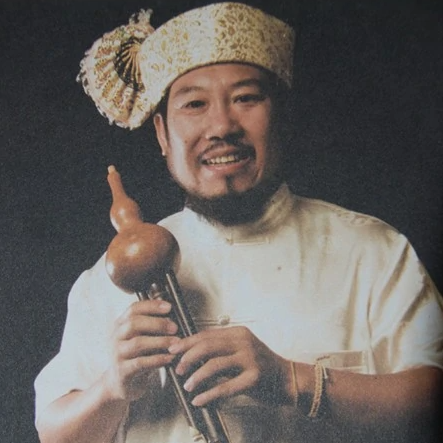Gen de quan
 Zhuo Dequan (1958-2008), male, junior high school education, started work in January 1976, first-level craftsman, vice chairman of the Chinese Music Society Hulusibawu Professional Committee. He is a famous Chinese cucurbit flute performer, composer and musician. He enjoys a high reputation in the world and the entire music industry, and is known as the "Father of Hulusi". He has visited, performed and lectured in the United States, Switzerland, Japan, South Korea, Taiwan, Hong Kong and other countries and regions.
Zhuo Dequan (1958-2008), male, junior high school education, started work in January 1976, first-level craftsman, vice chairman of the Chinese Music Society Hulusibawu Professional Committee. He is a famous Chinese cucurbit flute performer, composer and musician. He enjoys a high reputation in the world and the entire music industry, and is known as the "Father of Hulusi". He has visited, performed and lectured in the United States, Switzerland, Japan, South Korea, Taiwan, Hong Kong and other countries and regions.Born in 1958 in Banggai Village, Mengyang Town, Lianghe County. Zodequan grew up in the fertile soil of the cucurbit silk culture and was influenced by the art of cucurbit since he was a child. He learned how to play and make cucurbit silk from his grandfather and uncle when he was young. When he was young, he worked in a sugar factory and humbly offered to counties, states and provinces. Professional literature and art workers in the country seek advice and absorb all aspects of knowledge and nutrition. With his love for the art of cucurbit flute, he devoted himself to the study of production and performance techniques, made preliminary specifications for the production steps, and made significant contributions to the division of cucurbit syllables and the expansion of cucurbit flute.
Zhuodequan actively promoted and popularized the art of cucurbit silk, publicized and promoted the music culture of the Dai nationality, and was the first to improve and standardize the production process and pronunciation device of cucurbit silk, which completely changed the randomness, no classification, and tone of traditional folk production methods. Disadvantages such as not being allowed to make traditional folk musical instruments transform into specialized, standardized and standardized national musical instruments, and make them enter the hall of stage art. At the same time, together with other literary and artistic workers, they have improved and innovated the division of cucurbit flute and the expansion of the sound range, and the "Zodequan Brand" cucurbit flute has become the representative work of this Dai musical instrument and has been promoted to the whole country. Driven the development of the cucurbit silk industry.
Zide is diligent and tireless in promoting and popularizing the art of cucurbit silk and promoting and promoting the music culture of the Dai nationality. Cooperating with student Li Chunhua, he edited my country's first monograph on the teaching of cucurbita cucurbita, "Hulusi cucurbita audio tutorial", which filled the blank of standardized and systematic teaching of cucurbita in our country. Adhering to the teaching of folk music for a long time, he has been employed as a visiting professor at the Music College of Yunnan Arts University, Panzhihua College, Wuhan Conservatory of Music and other universities. Since 1989, more than 1,000 students have been taught, and there are more than 200 students from Japan, South Korea, Italy, France, the United States and other countries alone.
Gendequan actively carries out domestic and foreign national cultural and artistic exchanges, and promotes the culture of cucurbits to the whole country and the world. Participated in the creation and performance of large-scale literary and artistic programs for many times, and served as the lead singer and lead performer (Hulusi, Bawu) for some programs, such as the large-scale opera "Hulu Xin", the large-scale dance drama "Water Splashing Festival", and the opening of the second China International Tourism Festival. He also cooperated with the world-class art group, the Moscow Philharmonic Orchestra, and performed "Ancient Songs" and "Ancient Songs of Hulusi" in "Listening to Yunnan Small River Flowing Water". "Under the Golden Autumn Moon".
He has been invited many times to visit and perform in South Korea, the United States, Taiwan, Hong Kong and other countries and regions, to carry out academic exchanges, and to promote the music and art of cucurbit flute to the world. Through long-term unremitting efforts, cucurbit flute, a unique national traditional music and art of Dehong, has been further promoted and expanded. It is going to the whole country and the world, and the influence of Dehong national culture and art has also spread and expanded. . At the same time, he has also been widely praised and praised by experts, scholars and all sectors of society.
Similar artist
Involving musical instruments
Involved portfolio
Involved news
Popular artists
- 01 Cui Jianghui
- 02 bump peng peng peng
- 03 Su Chang
- 04 Moyun
- 05 Li Xianyue cherish
 渝公网安备 50010702504639号
渝公网安备 50010702504639号